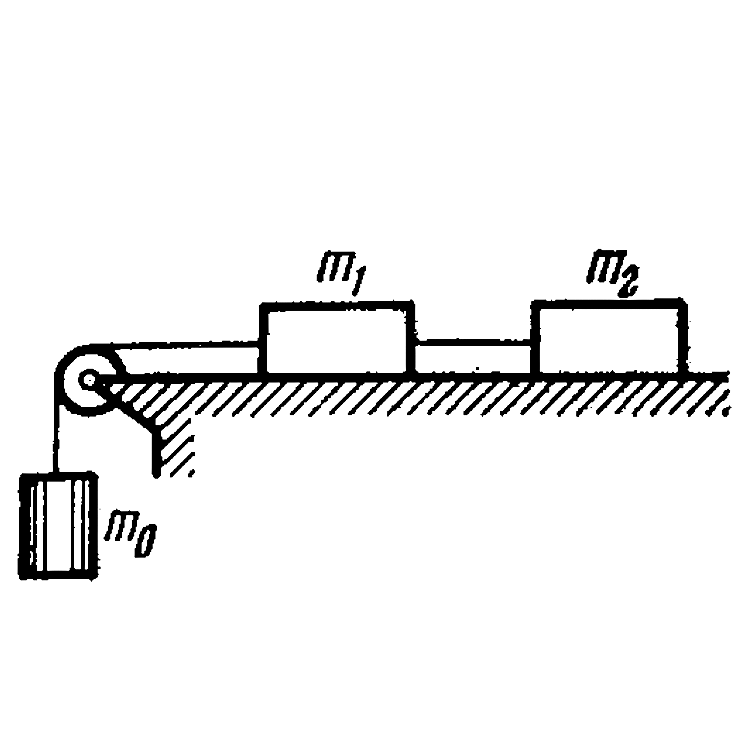In the arrangement shown in the figure, the blocks have masses 3m,m and 2m, the friction is absent, the masses of the pulleys and the threads are negligible. Find the acceleration of mass 3m.

Let the pulley Q falling with acceleration a0 with respect to the pulley, its acceleration is a0
 Let the acceleration of block A (mass 3m) w.r.t. the pulley be a
Let the acceleration of block A (mass 3m) w.r.t. the pulley be a
aA/g=aA/p+ap/g=(a+a0) in downward direction
aB/g=aB/p−ap/g=(a−a0) in upward direction

3mg−T=3m(a+a0) (i)

T−mg=m(a−a0) (ii)

2T=2ma0 (iii)
From (iii), T=ma0 in (i) and (ii)
3mg−ma0=3m(a+a0)⇒3a+4a0=3g (iv)
ma0−mg=m(a−a0)⇒a−2a0=−g (v)
Solving (iv) and (v), we get
a=85,a0=3g5
Acceleration of mass 3m with respect to the ground is
a+a0=4g5
Topper's Solved these Questions
Similar Questions
In the arrangement shown in figure the bodies have masses m0, m1, m2, the friction is absent, the masses of the pulleys and the threads are negligible. Find the acceleration of the body m1. Look into possible cases.

View SolutionIn the arrangement shown in fig the bodies have masses m0,m1andm2 the friction is absent the masses of pulleys and the threads are negligible find the acceleration of the body m1

View Solution
Knowledge Check
In the arrangement shown in figure , there is friction between the blocks of masses m and 2m which are in contact . The ground is smooth . The mass of the suspended block is m . The block of mass m which is kept on mass 2m is stationary with respect to block of mass 2 m . The force of friction between m and 2 m is (pulleys and string are lig frictionless ) :
 Amg2Bmg√2Cmg4Dmg3
Amg2Bmg√2Cmg4Dmg3
In the arrangement shown in figure the masses of the wedge M and the body m are known. The appreciable friction exists only between the wedge and the body m, the friction coefficient being equal to k. The masses of the pulley and the thread are negligible. Find the acceleration of the body m relative to the horizontal surface on which the wedge slides.

View SolutionIn the arrangement of figure the masses m0, m1, and m2 of bodies are equal, the masses of the pulley and the threads are negligible, and there is no friction in the pulley. Find the acceleration w with which the body m0 comes down, and the tension of the thread binding together the bodies m1 and m2, if the coefficient of friction between these bodies and the horizontal surface is equal to k. Consider possible cases.

View SolutionA pulley fixed to the ceiling carries a thread with bodies of masses m1 and m2 attached to its ends. The masses of the pulley and the thread are negligible, friction is absent. Find the acceleration wC of the centre of inertia of this system.
View SolutionIn the arrangement shown in figure the masses m of the bar and M of the wedge, as well as the wedge angle α, are known. The masses of the pulley and the thread are negligible. The friction is absent. Find the acceleration of the wedge M.

View SolutionA pulley fixed to the ceiling carries a thread with bodies of masses m1 and m2 attached at its ends. The masses of the pulley and thread are negligible, friction is absent. Find the acceleration of the centre of mass(acm) of this system.
View SolutionA pulley fixed to the ceiling carried a thread with bodies of masses m1 and m2 attached to its ends. The mases of the pulley and the thread are negligible and friction is absent. Find the acceleration of the centre of mass of this system.

View SolutionIn the arrangement shown in figure-2.68 the masses of the wedge M and the body m are known. There is no friction at any of the surfaces. The mass of the pulleys and thread is negligible. Find the acceleration of the body m relative to the horizontal surface on which the wedge slides.

[√2mgM+2m]
View Solution
